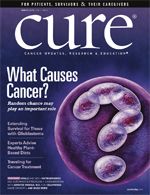Publication
Article
CURE
What Causes Cancer? Three Main Culprits
Author(s):
Why me? Why did I get cancer? This is the most common question asked upon diagnosis — we naturally seek an explanation for big events in life.
Debu Tripathy, MD

Debu Tripathy, MD
WHY ME? WHY DID I GET CANCER? This is the most common question asked upon diagnosis — we naturally seek an explanation for big events in life.
The answer is complicated and probably different for each case. There are three major factors, as best we know: inherited predisposition (genetics), environmental/ toxic exposure and random chance. But the relative contribution of each varies and is difficult to pinpoint with our current level of knowledge. For example, tobacco use is clearly the main determinant for lung cancer — as are other less common environmental factors such as radon gas and cooking oil exposure. However, for other cancers, such as ovarian, a high proportion of affected patients have a hereditary predisposition, in this case BRCA1 and 2 gene mutations. It is estimated that, across the board, about 30 percent of cancers are caused by inherited genetic factors — the latest evidence comes from a large study of cancers in identical twins. The percentage is even higher in rarer familial malignancies, like certain endocrine cancers.
Random chance also plays a role — maybe even the dominant role in many types of cancer in which no identifiable cause can be found in patients. Mistakes in the normal process of DNA division can cause mutations, a small fraction of which can give the mutated cell a growth advantage, and as these genetic changes pile up, the ultimate result is cancer. By the time of diagnosis, the cancer cells may already possess numerous tools for evading immune surveillance and cancer drugs, and for spreading to other parts of the body.
Studies have shown that the number of stem cell divisions that immature cells undergo to form specialized tissues and organs correlates closely with the risks of different types of cancers. This implies that chance plays a hand, as every DNA division is a spin of the roulette wheel that could generate a mistake. That is why age itself is a common risk factor, although some cancers are more frequent at younger ages, when the division rate of the affected tissue is highest, such as osteosarcoma — the bone growth plates tend to close in adolescence, which is when and where these cancers of the bone tend to occur. In fact, one strategy to prevent cancer could be to learn more about diets, activities and even drugs that can improve the fidelity of DNA division and the body’s ability to repair mistakes.
Our winter issue of CURE magazine examines all of these risk elements in one article to give a broad understanding of where cancer comes from — and emphasizes that every case of cancer takes a different road, making the breakdown of each causative factor in individual cases impossible. Luckily, this mosaic of origins doesn’t make treatment impossible; rather, trends toward personalized cancer diagnosis and treatment are making us ever more capable of dealing with the curve balls nature throws us.
DEBU TRIPATHY, MDEditor-in-ChiefProfessor of MedicineChair, Department of Breast Medical OncologyThe University of Texas MD Anderson Cancer Center





